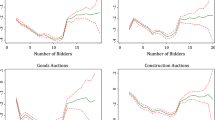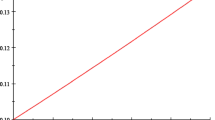Abstract
This study empirically investigates the impact of public procurement regulation quality on the competition for tenders and the cost-effectiveness of awarded contracts, by employing the World Bank’s Benchmarking Public Procurement and EuroPAM Public Procurement quality scores. Using extensive data on public procurement in the European Economic Area, Switzerland, and Macedonia, the analysis in this paper shows that higher quality public procurement regulatory regimes are associated with higher levels of competition and cost-effectiveness. Improved regulation quality significantly increases the number of bidders and the probability that the procurement price is lower than the estimated cost.



Similar content being viewed by others
Notes
The African Investor Survey (AIS), which is administered by the United Nations Industrial Development Organization.
EuroPAM questionnaire about public procurement is available at http://europam.eu/data/in-law%20indicators/EuroPAM%20Public%20Procurement%20indicator%20list.pdf.
EuroPAM public procurement indicator list is available online at http://europam.eu/data/in-law%20indicators/EuroPAM%20Public%20Procurement%20indicator%20list.pdf. The details of the scoring methodology are available online at http://europam.eu/data/in-law%20indicators/EuroPAM%20scoring%20for%20Public%20Procurement.pdf.
The BPP does not calculate public procurement scores for Malta. Whereas, EuroPAM does not calculate public procurement scores for Macedonia FYR. Tables OA.4 and OA.5 in the Online Appendix display the BPP and EuroPAM scores for each country.
I use the contact award notices csv files. The files are available at https://data.europa.eu/euodp/data/dataset/ted-csv.
The standard forms prescribed by the EU are available at http://simap.ted.europa.eu/web/simap/standard-forms-for-public-procurement.
Common Procurement Vocabulary (CPV) establishes a single classification system for public procurement aimed at standardizing the references used by contracting authorities and entities to describe the subject of procurement contracts.
Values larger than 50 (2%) are not displayed for the sake of brevity.
44 contracts have 999 bidders.
Djankov et al. (2017) does not have public procurement regulation scores for Liechtenstein and Malta. The TED data set contains 311 contracts for Liechtenstein and 2518 for Malta.
Rigobon and Sack (2003) used a similar identification technique to assess the reaction of monetary policy to the stock market. Lewbel (2012) generalizes this identification technique. Accordingly, it can be applied to datasets with different structures, including the TED data set. The method developed by Lewbel (2012) identifies structural parameters by constructing instruments as functions of the model’s data when valid instrumental variables do not exist. This approach provides an unbiased and consistent estimate of parameters when the regression model contains endogenous or mismeasured regressors, or when it suffers from the omitted-variable bias. The Monte Carlo results and numerous empirical applications presented in Lewbel (2012) show that the estimator works very well compared to the two-stage least squares method and to GMM when suitable instrumental variables are not available. The methodology uses the heteroscedasticity of the errors to construct valid IVs; further, consistent and unbiased parameters of the empirical model can be estimated by employing these IVs in an IV-GMM setting.
I employ year fixed effects in these regressions.
References
Bajari, P., Houghton, S., & Tadelis, S. (2014). Bidding for incomplete contracts: An empirical analysis of adaptation costs. American Economic Review,104(4), 1288–1319.
Bajari, P., Tadelis, S., & McMillan, R. (2009). Auctions versus negotiations in procurement: An empirical analysis. Journal of Law Economics and Organization,25, 372–399.
Baldi, S., Bottasso, A., Conti, M., & Piccardo, C. (2016). To bid or not to bid: That is the question: Public procurement, project complexity and corruption. European Journal of Political Economy,43, 89–106.
Billor, N., Hadi, A. S., & Velleman, P. F. (2000). BACON: Blocked adaptive computationally efficient outlier nominators. Computational Statistics & Data Analysis,34, 279–298.
Branzoli, N., & Decarolis, F. (2015). Entry and subcontracting in public procurement auctions. Management Science,61, 2945–2962.
Campbell, C. M., & Levin, D. (2000). Can the seller benefit from an insider in common value auctions? Journal of Economic Theory,91(1), 106–120.
Campos, E., & Sanjay, P. (2007). The many faces of corruption: Tracking vulnerabilities at the sector level. Washington, DC: The World Bank.
Conley, T. G., & Decarolis, F. (2016). Detecting bidders groups in collusive auctions. American Economic Journal: Microeconomics,8(2), 1–38.
Coviello, D., Guglielmo, A., & Spagnolo, G. (2018). The effect of discretion on procurement performance. Management Science, 64(2), 715–738.
Coviello, D., & Mariniello, M. (2014). Publicity requirements in public procurement: Evidence from a regression discontinuity design. Journal of Public Economics,109, 76–100.
De Silva, Dakshina G., Dunne, Timothy, Kankanamge, Anuruddha, & Kosmopoulou, Georgia. (2008). The impact of public information on bidding in highway procurement auctions. European Economic Review,52, 150–181.
Decarolis, F. (2018). Comparing public procurement auctions. International Economic Review,59, 39–419.
Djankov, S., Ghossein, T., Islam, A.M., & Saliola, F. (2017). Public procurement regulation and road quality. World Bank Policy Research Working Paper 8234.
Ghossein, T., Islam, A.M., & Saliola, F. (2018). Public Procurement and the Private Business Sector. World Bank Policy Research Working Paper 8575.
Gourdon, J., & Messent, J. (2017). Emerging Policy Issues: Measures Affecting Trade in Government Procurement Process. Trade and Agricultural Directorate Trade Committee Working Party of the Trade Committee (TAD/TC/WP (2015)26/FINAL, Organization for Economic Co-operation and Development, OECD, Paris.
Harstad, R. M. (1990). Alternative common-value auction procedures: Revenue comparisons with free entry. Journal of Political Economy,98, 421–429.
Herz, B., & Varela-Irimia, X. (2017). Border Effects in European Public Procurement. MPRA Paper No. 80138.
Hoekman, B., & Sanfilippo, M. (2018). Firm performance and participation in public procurement: Evidence from Sub-Saharan Africa. RSCAS Working Papers 2018/16, European University Institute.
Ishii, R. (2009). Favor Exchange in Collusion: Empirical Study of Repeated Procurement Auctions in Japan. International Journal of Industrial Organization,27, 137–144.
Knack, S., Biletska, N., & Kacker, K. (2017). Deterring Kickbacks and Encouraging Entry in Public Procurement Markets. World Bank Policy Research Working Paper No:8078.
Krasnokutskaya, E., & Seim, K. (2011). Bid preference programs and participation in highway procurement auctions. American Economic Review,101, 2653–2686.
Kutlina-Dimitrova, Z., & Lakatos, C. (2016). Determinants of direct cross-border public procurement in EU Member States. Review of World Economy,152, 501–528.
Lewbel, A. (2012). Using heteroscedasticity to identify and estimate mismeasured and endogenous regressor models. Journal of Business and Economic Statistics,30, 67–80.
Lewbel, A. (2018). Identification and estimation using heteroscedasticity without instruments: The binary endogenous regressor case. Economics Letters,165, 10–12.
Milgrom, P. R., & Weber, R. J. (1982). A theory of auctions and competitive bidding. Econometrica,50, 1089–1122.
Nakabayashi, (2013). Small business set-asides in procurement auctions: An Empirical analysis. Journal of Public Economics,100, 28–44.
OECD. (2012). Guidelines for fighting bid rigging in public procurement: Helping Governments to Obtain Best Value for Money. https://www.oecd.org/competition/cartels/42851044.pdf
Ohashi, H. (2009) Effects of Transparency in Procurement Practices on Government Expenditure: A Case Study of Municipal Public Works. Rev Ind Organ, 34, 267–285.
Palguta, J., & Pertold, F. (2017). Manipulation of procurement contracts: Evidence from the introduction of discretionary thresholds. American Economic Journal,9, 293–315.
Rigobon, R., & Sack, B. (2003). Measuring the reaction of monetary policy to the stock market. The Quarterly Journal of Economics,118, 639–669.
Tas, B. K. O. (2020) Effect of Public Procurement Regulation on Competition and Cost-Effectiveness. Robert Schuman Centre for Advanced Studies Research Paper No. RSCAS 2020/36. Available at SSRN: http://doi.org/10.2139/ssrn.3607128
Wittig, W. A. (2002) Public Procurement and the Development Agenda. International Trade Center, United Nations Conference on Trade and Development and World Trade Organization, available online at: https://www.wto.org/english/tratop_e/gproc_e/wkshop_tanz_jan03/itcdemo1_e.pdf. (Accessed 20 October 2018)
World Bank. (2012). Why Reform Public Procurement? https://www.worldbank.org/content/dam/Worldbank/document/MNA/Why_Reform_Public_Procurement_English.pdf. Accessed October 18, 2018.
Author information
Authors and Affiliations
Corresponding author
Additional information
Publisher's Note
Springer Nature remains neutral with regard to jurisdictional claims in published maps and institutional affiliations.
The first version of the paper was written when I was a Jean Monnet Research Fellow at the EUI Robert Schuman Centre for Advanced Studies (RSCAS). I am grateful for the hospitality of the EUI RSCAS.
Tas (2020) contains the online appendix. Online Appendix is available at http://ssrn.com/abstract=3607128.
Rights and permissions
About this article
Cite this article
Tas, B.K.O. Effect of public procurement regulation on competition and cost-effectiveness. J Regul Econ 58, 59–77 (2020). https://doi.org/10.1007/s11149-020-09409-w
Published:
Issue Date:
DOI: https://doi.org/10.1007/s11149-020-09409-w




